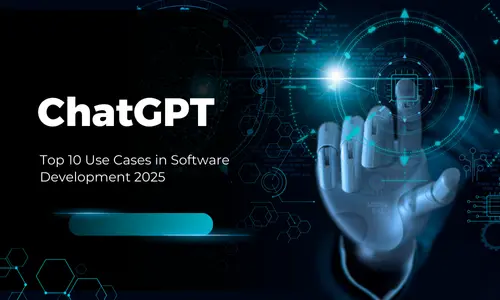In the fast-evolving world of software development, artificial intelligence continues to redefine how developers work, innovate, and solve problems. Among the many AI tools available, ChatGPT stands out as a game-changer. By 2025, this powerful language model, developed by OpenAI, has found its way into numerous aspects of software engineering, enhancing productivity and creativity. Whether you're a seasoned coder or a beginner, understanding the top use cases of ChatGPT in software development can give you a competitive edge. In this blog, we’ll explore the ten most impactful ways this tool is shaping the industry.

Why ChatGPT Matters in Software Development
Before diving into the use cases, it’s worth understanding why ChatGPT has become indispensable. Its ability to process natural language and generate human-like responses makes it an ideal companion for developers. From writing code to debugging errors, it streamlines workflows and reduces manual effort. As we move deeper into 2025, the integration of AI tools like this one into development environments is no longer optional—it’s essential.
Top 10 Use Cases of ChatGPT in Software Development
1. Code Generation and Automation
One of the most popular applications of ChatGPT in 2025 is its ability to generate code snippets. Developers can describe what they need—say, a Python function to sort a list—and the tool delivers accurate, functional code in seconds. This saves time on repetitive tasks and allows coders to focus on higher-level problem-solving. Whether it’s JavaScript, Python, or C++, the tool adapts to various languages effortlessly.
2. Debugging and Error Resolution
Every developer knows the frustration of staring at a bug for hours. ChatGPT simplifies this by analyzing code and suggesting fixes. By pasting a snippet and describing the issue, developers receive detailed explanations and solutions. In 2025, this use case has become a lifesaver for teams working under tight deadlines, reducing debugging time significantly.
3. Writing Documentation
Documentation is often the least favorite task for developers, yet it’s critical for collaboration and maintenance. With ChatGPT, creating clear, concise, and professional documentation is a breeze. Feed it your code or project details, and it generates user manuals, API docs, or README files that are easy to understand—perfect for onboarding new team members.
4. Learning and Upskilling
The tech world moves fast, and staying updated is a constant challenge. Developers in 2025 use ChatGPT as a personal tutor. Whether it’s mastering a new framework like React or understanding complex algorithms, the tool explains concepts in simple terms, provides examples, and even quizzes users to reinforce learning.
5. Prototyping and Mockups
Before building a full-fledged application, developers often create prototypes to test ideas. ChatGPT assists by generating boilerplate code for web apps, mobile interfaces, or backend systems. This speeds up the prototyping phase, allowing teams to experiment and iterate without investing too much time upfront.
Enhancing Collaboration with ChatGPT
6. Code Review Assistance
Code reviews are essential for maintaining quality, but they can be time-consuming. In 2025, developers lean on ChatGPT to pre-review code, catching syntax errors, suggesting optimizations, and ensuring adherence to best practices. While it doesn’t replace human reviewers, it lightens their load and improves overall efficiency.
7. Team Communication and Query Resolution
In distributed teams, quick communication is key. ChatGPT acts as a virtual assistant, answering technical questions like “How do I implement OAuth in Node.js?” or “What’s the best database for real-time apps?” This reduces back-and-forth in Slack channels and keeps projects moving forward smoothly.
Advanced Applications in 2025
8. Test Case Generation
Writing test cases is critical for ensuring software reliability, but it’s often tedious. ChatGPT steps in by analyzing code and producing unit tests, edge cases, and even integration tests. Developers in 2025 rely on this feature to improve code coverage and catch bugs before deployment, all with minimal effort.
9. Natural Language to Code Translation
Imagine describing an app feature in plain English—like “I want a button that saves user input to a database”—and getting functional code instantly. This is a reality in 2025, thanks to ChatGPT’s advanced natural language processing. It bridges the gap between non-technical stakeholders and developers, making collaboration seamless.
10. Optimizing Legacy Code
Many companies still rely on outdated systems written in languages like COBOL or PHP. ChatGPT helps modernize these by suggesting refactoring strategies, converting old code into modern frameworks, or even explaining how ancient logic works. This use case is a boon for businesses looking to upgrade without starting from scratch.
Benefits of Integrating ChatGPT into Development Workflows
The use cases above highlight how ChatGPT transforms software development, but the benefits go deeper. It boosts productivity by automating repetitive tasks, enhances code quality through intelligent suggestions, and fosters innovation by allowing developers to experiment freely. In 2025, teams that embrace this tool consistently deliver projects faster and with fewer errors.
Challenges to Consider
No tool is perfect, and ChatGPT has its limitations. It may occasionally produce inaccurate code or misinterpret complex requirements. Developers must verify its output, especially for critical systems. Additionally, over-reliance could hinder problem-solving skills over time. Striking a balance between AI assistance and human expertise is key to maximizing its value.
The Future of ChatGPT in Software Development
As we look beyond 2025, the role of ChatGPT in software development will only grow. With advancements in AI, we can expect even smarter features—like real-time collaboration within IDEs or predictive coding based on project history. For now, mastering its current capabilities gives developers a head start in an increasingly competitive field.
Conclusion
ChatGPT has revolutionized software development in 2025, offering a versatile toolkit for coders of all levels. From generating code and debugging errors to writing docs and optimizing legacy systems, its use cases are as diverse as they are powerful. By integrating this tool into your workflow, you can save time, enhance quality, and stay ahead of the curve. Ready to leverage AI in your next project? The future of development is here—embrace it.